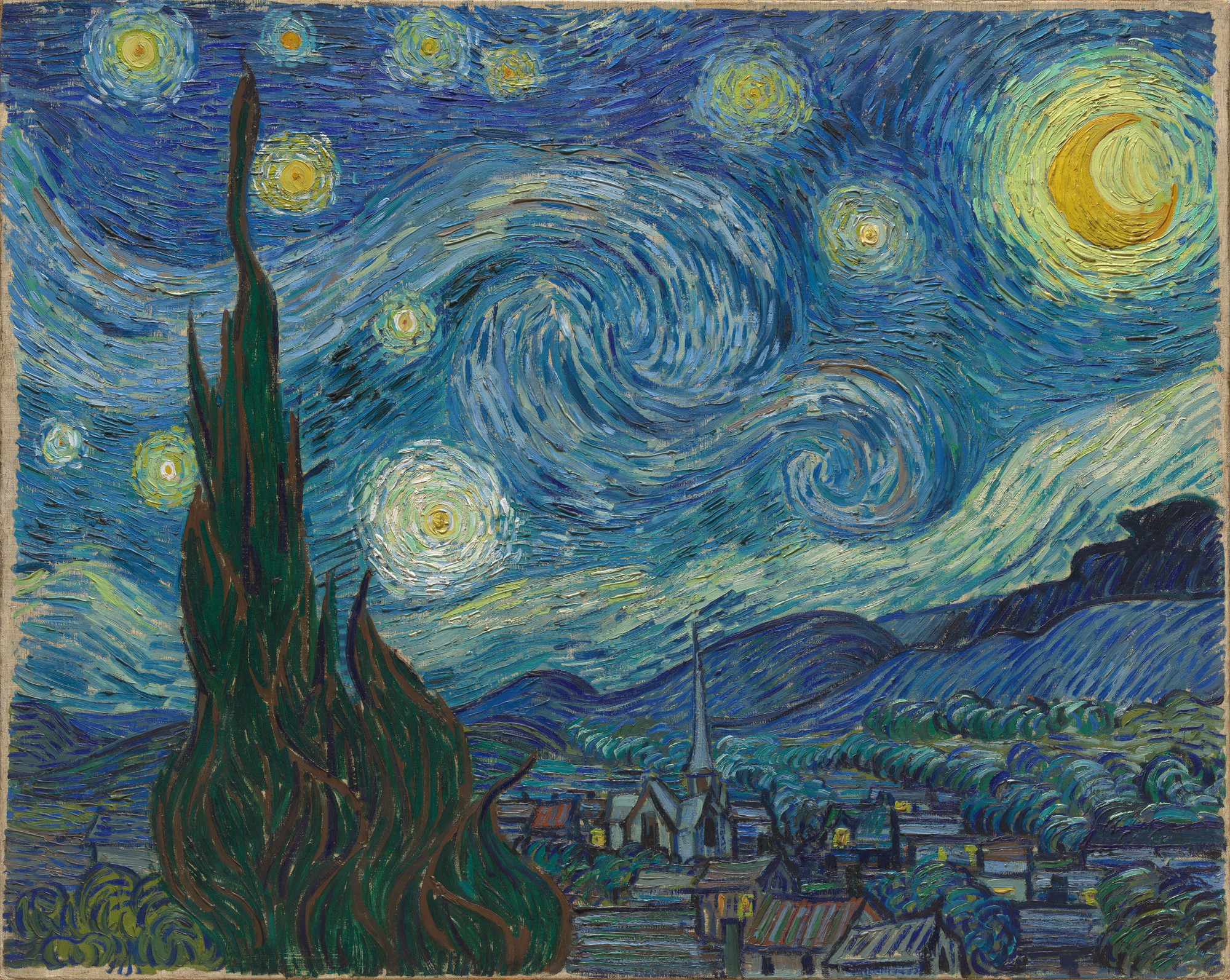Narrator: The artist Vincent Van Gogh made The Starry Night in 1889, using oil paint on canvas. The work is about two feet, five inches high and three feet wide. In metric units, it is about 74 centimeters high and 92 centimeters wide.
The Starry Night is inspired by the view from Vincent van Gogh’s window at an asylum in Saint-Rémy, in southern France, where he spent a year receiving treatment for mental illness. The painting is both an exercise in observation and a departure from it.
Van Gogh applied the paint—mostly deep blues and vivid yellows—in thick layers of rhythmic brushstrokes resulting in a highly textured surface.
The scene is dominated by a crescent moon and starry night sky, which fill the upper two thirds of the canvas. The sky is the most dynamic part of the painting. It stands in contrast to a quiet village, nestled below treetops and rolling hills, in the lower third of the painting. On the far left side, a large cypress tree in the foreground commands attention.
Beginning at the top, the turbulent sky is painted in hundreds of short, thickly applied brushstrokes, which give the appearance of roiling movement. Towards the top of the canvas the sky is a dark lapis blue, which gets lighter closer to the horizon.
The sky is punctuated by 10 dazzling stars. Halos of concentric circles surround these glowing orbs. In most cases, van Gogh dots their center with a saturated yellow or orange, then adds light green to transition from these warmer colors to the deep blues of the sky. The smallest orb is the size of a golf ball and the largest is as big as an apple.
In the upper right corner, hangs a vibrant yellow crescent moon, also surrounded by strokes of yellow, green, and blue paint forming a circle around it.
In the middle of the sky, swirling light blue bands—like two letter “S’s” on their sides— tumble in horizontally from the left of the canvas, suggesting a tempestuous wind. Below, a lighter, denser band of clouds lines the horizon. Between these layers, is a golden orb surrounded by a white halo of paint that may be Venus, which is known as the morning star.
In the lower third of the painting, rolling hills stretch across the width of the canvas. They are made of diagonal blue brushstrokes. Below the hills, on the right side of the painting, are blue-green treetops made from curved brush strokes.
In front of the trees, about a dozen rooftops are visible, as if seen from a hill overlooking the town. The houses are rendered with straight horizontal, vertical, and diagonal lines and painted in muted, nighttime tones, including gray, black, blue, and rust brown. A few are dotted with yellow squares to indicate light coming from their interiors. A blue-gray church stands in the center of the town, its pointed steeple barely breaches the horizon. The little village bears no resemblance to the real village of Saint-Rémy but draws inspiration from van Gogh’s native Holland.
Just left of center, rising up from the bottom of the canvas, a towering cypress tree dominates the foreground, connecting and bisecting land and sky. It’s painted with dark green, brown, and black brushstrokes, and its branches resemble the shape of flames. The tree is wide at the bottom of the canvas and tapers to a point near the top. Of all the features in the painting, the tree is nearest to us, and the darkest in color.
Now we’ll explore this work further with a curator.
Curator, Ann Temkin: What's remarkable about The Starry Night is the depiction of the sky itself. We have an intensely turbulent, vibrant, excited, agitated night sky. The stars have radiating concentric rings of light. The moon has the same set of rings around it. And also they're set in a sky which is not like the sky that we look up into at night, but one in which the various blues that Van Gogh uses are positioned into these swirling patterns.
And I think one would be able to speculate, rather than being a portrait of what one might see looking up at a night sky in the summer of 1889, it's much more an expression of the turmoil in the artist's own imagination that he's projecting onto that sky.
Chances are you aren't standing in front of this painting alone. You're probably surrounded by quite a few people also looking at it. And I think with this painting, one realizes that part of the reason for its status as such a treasure, and the way it's beloved by so many people, has to do with Van Gogh's way of touching one's emotions.
